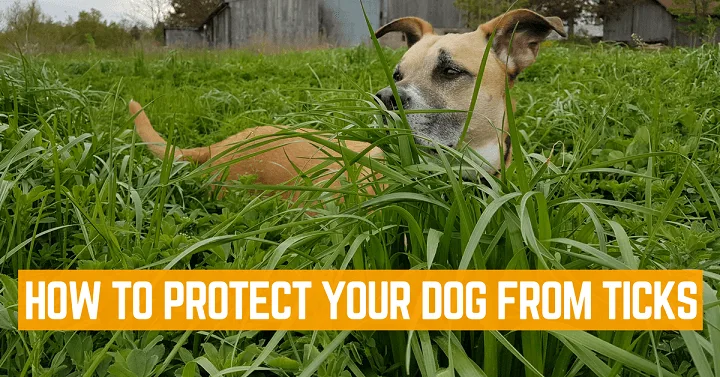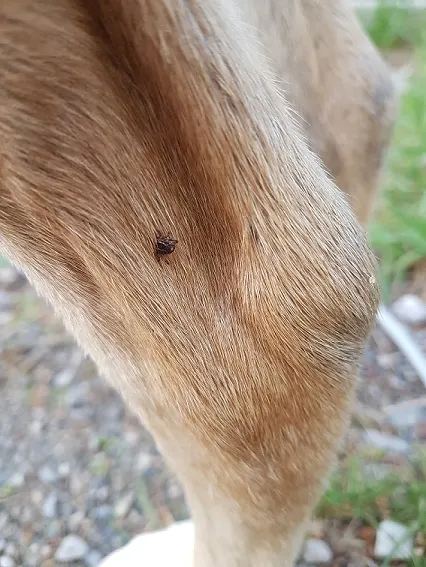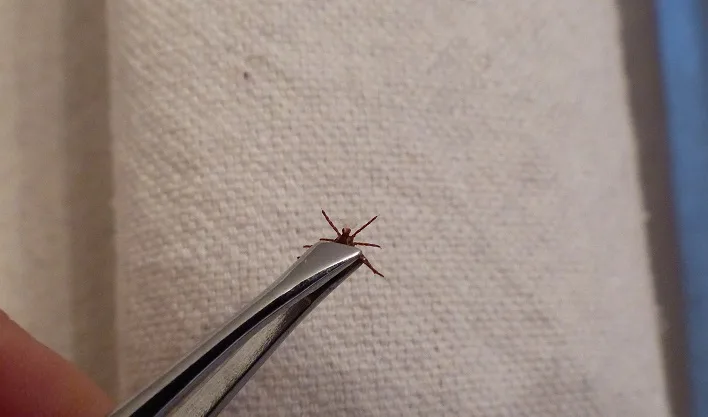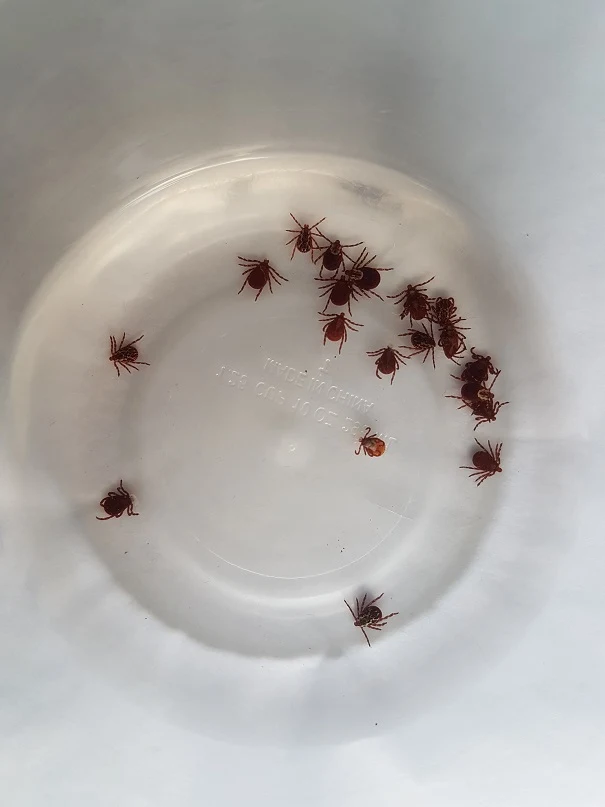This spring has been a terrible season for ticks. At our farm in Southern Ontario, we are now up to 19 ticks that we have pulled off of the dog and ourselves. This is far and away a record year for us.
Ticks are known for spreading several different diseases and causing serious health concerns for humans and dogs. It’s important to be careful and protect yourself and your pet during tick season.
According to the CDC, “tickborne diseases can result in mild symptoms treatable at home to severe infections requiring hospitalization.” Symptoms for humans and animals are often very similar: joint pain and fever are the most common. Different kinds of ticks are found in different geographic areas and at different times of the year. Not every tick carries disease and not every kind of tick bites humans.
Do your research and understand whether ticks are a concern in your area. Then take steps to keep yourself and your pet healthy. Here—in a helpful t-i-c-k acronym—I share some of the lessons we’ve learned living in tick country.

Take your medicine
There are a variety of tick medications available. Some of these are repellents to discourage ticks from landing or biting. Some are pesticides that kill ticks. Medications come in sprays, collars, topical and chews. There is also a Lyme disease vaccine available for dogs. Discuss options with your vet, weigh the risks and make the choice that’s best for your dog. For us, we give Baxter one NexGard chew a month.
If your dog does contract a tickborne illness, depending on the sickness, there may not be treatment options available.
Our vet provides a test called the 4dx which tests for:
- Lyme disease
- heartworm
- anaplasmosis and
- erlichiosis.
When I shared my tick woes on Instagram, some of the solutions people suggested included a spray of rose geranium essential oil mixed with vodka, or lemon eucalyptus with jojoba for a powder. Even catnip was cited as a repellent.
With any treatment options, be careful and educate yourself about what is safe and best for your dog. For example, our vet said to be cautious about using essential oils for tick prevention because they have not been tested for efficacy in the same way that the prescription products have been.
Inspect, inspect, inspect
The best way to deal with ticks is to spot them.
Baxter gets a full nose to tail examination every time he comes inside. I look in his ears, under his tail, between his legs, between his toes, in his armpits. I run my hands over his head, body, belly, groin, legs to feel for bumps. We’ve found ticks crawling on him, and we’ve also found ticks that have bit him.

If your dog has long or dark hair, ticks may be hard to spot. Make sure you take the time to do a thorough inspection. Ticks might be carried inside on your clothes or your dog’s fur—some ticks may hang out for awhile before they bite. You really don’t want them crawling around in your house.
If I find a tick, I pull it off with tweezers and put it in a jar of rubbing alcohol. For ticks that are already attached, grasp firmly with tweezers as close to the skin as possible and pull straight out. You may be surprised how securely the tick is attached. Don’t twist or bend the tick. You want to extract its mouth and head all in one piece.
Our vet said that sometimes the mouth parts of the ticks often do break off in the skin, as they are barbed and most often anchored into the skin. This is not a big deal, according to our vet, because the dog’s body will break this down and eject it, sort of like a little pimple.

Don’t forget to inspect yourself as well.
Cut the grass
Ticks like long grass, leaves and brush. They hang out, waiting for a warm body to walk by, and then they hop aboard. Keep your yard mowed and avoid walking in fields or overgrown areas during tick season. For us at the farm, most of our walks take place in our fields. We have several mowed paths, which my husband has widened as a result of our experience this spring. We’ve also driven to residential areas for our walks a couple of times.

A second ‘C’ tip for humans: cover up. Wear long pants, long sleeves, tall boots. Tuck your pants into your boots and your shirt into your pants to limit the amount of skin that is exposed. Wear light colours so that ticks are easier to see on your clothing.
Knowledge is power
As with any health concern, it’s important to educate yourself. Know what ticks live in your area and what they look like. Know the symptoms of tickborne illnesses and keep an eye on your pet if he is bitten.
Talk to your vet about what to watch out for, what treatments or preventative options are best and any concerns you have.
Ticks are not a cause for panic. You can still go outside and you can still enjoy nature with your dog. Be vigilant. Take precautions. Be prepared.

Do you have ticks in your area? What are your techniques for dealing with ticks?
Let us know in the comments!
Julia Thomson is a blogger at Home on 129 Acres where she writes about her adventures of country living and DIY renovating. She and her husband live on a 129-acre farm in Ontario, Canada.

Issia Jordan
Monday 19th of June 2017
I'm surprised you say in your post not to twist when removing a tick, here we are told to use a tick tool and twist to ensure the head comes too, otherwise the tool is likely to remove the body and not the head.
Sandy Weinstein
Tuesday 13th of June 2017
i just heard on the news it is going to be a bad season for ticks b/c the winter was so warm. my dogs have not been bite but i have found a few. i have already had many ticks bites, but i can feel them walking on me so i get them off fast.
Ana @ HJRT
Tuesday 13th of June 2017
You can never be too careful. Some kind of pest repelant (preferably all-natural) and a tick removal tool are always by my side this time of year.
Sandy Weinstein
Sunday 11th of June 2017
i have already been bitten many times this year. i like using homeopathic products, my favorite is by Nature's Farmacy, flea free, works great. you can make it as strong as you need. you mix it with dawn, and spring water. this is the best homeopathic flea/tick product i have every used. for me, when i get bit, i use Jackson Galaxy products, the vaccine detox. it makes the redness go away and the swelling. it is homeopathic as well. i hate the tiny ones that are the size of a pin. luckily i can feel them 99% of the time. i take Doxycycline for tick bits.
M.A. Kropp
Tuesday 6th of June 2017
Ticks have been horrible the past few years in MA! I have pulled six off Lambeau after just one walk on a reservation area near us. And some off myself, as well. Lambeau wears a Soresto collar, which has helped (some) and I rub his legs and underbelly with cedar oil before we go out to wooded or grassy areas for walks. For me, I spray my clothes with permethrin and use a picaridin lotion on my skin, as well as cedar oil spray. Nothing's 100% effective, but this combination seems to help minimize the ones I do find. They are nasty, persistent little buggers! One note on the cedar oil- if you do decide to try it and you have cats, make sure you get a type that has had the phenols removed. I use Wondercide and don't put it on the cats themselves (they are indoor only) but I know it is safe to use on the dog- who they will rub against and sleep next to- and clothing they might be exposed to.
Julia at Home on 129 Acres
Wednesday 7th of June 2017
Six in one walk!? That beats our record (4). Thanks for sharing how you discourage them.